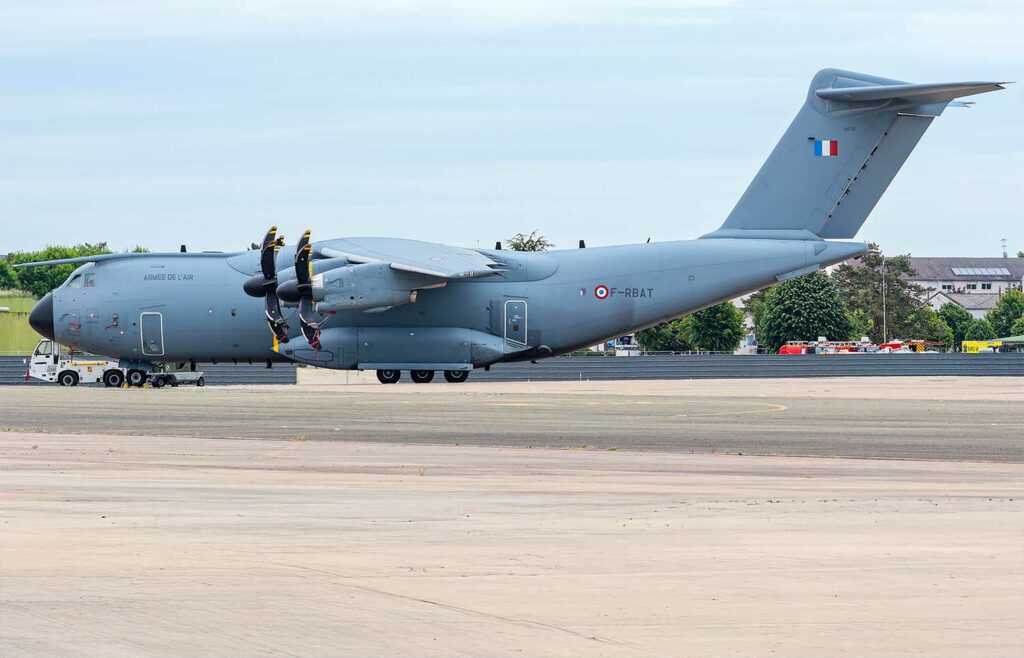
France is mobilizing A400M aircraft to evacuate its citizens from Israel to Cyprus amid rising security tensions in the Middle East.
The French government has announced the mobilization of A400M military transport aircraft to evacuate its citizens from Israel to Cyprus. This decision was approved during a National Defense and Security Council meeting held at the Élysée Palace in response to the regional escalation marked by Israeli strikes against Iranian infrastructure and the threat of retaliation targeting urban areas.
France has nearly 250,000 nationals in Israel, including 100,000 registered with the consular registry. The activation of such a logistical operation reflects the seriousness of the situation. The first repatriation operations began at the end of June, under the joint coordination of the Ministry for Europe and Foreign Affairs and the Air and Space Force.
Planes are taking off from Ben Gurion Airport in Tel Aviv and landing in Larnaca, in the Republic of Cyprus, which is playing a central role in the evacuation operation.
A massive influx of requests for assistance
The rapid deterioration of the security situation led to an influx of calls to the Quai d’Orsay Crisis Center. In the space of a week, more than 4,500 requests were recorded, from both permanent French residents and tourists.
The French community in Israel is one of the largest abroad. Many are based in Tel Aviv, Jerusalem, and Haifa, but a significant number live in border areas, which are more exposed to possible strikes. The Quai d’Orsay therefore deemed it necessary to prioritize the most vulnerable: families with children, the elderly, and nationals in fragile medical conditions.
This context is reminiscent of previous crisis management operations, such as Operation Baliste in Lebanon in 2006, when several thousand people were evacuated urgently by the French Navy and air assets.
The capabilities of the A400M Atlas
The Airbus A400M Atlas is at the heart of this operation. Entering service with the French Air and Space Force in 2013, this aircraft is capable of combining strategic and tactical transport.
- Payload capacity: approximately 37 tons of equipment or up to 116 passengers in troop transport configuration. For evacuations, the configuration selected can accommodate approximately 100 people per flight, with their essential luggage.
- Range: a range of 3,300 km with a payload of 20 tons, more than enough to fly from Tel Aviv to Larnaca (approximately 350 km).
- Versatility: the aircraft can also be used for medical missions. An A400M can be configured in a MEDEVAC version and accommodate up to 66 stretchers and medical personnel.
These features make it ideal for evacuations in unstable environments. The pressurized cabin, rear ramp, and ability to operate from semi-prepared runways further enhance its flexibility.
First flights and figures for the operation
The first military flight evacuated 102 French nationals to Cyprus. Upon arrival, the passengers were taken care of by the French Embassy and temporarily housed before being returned to Paris.
In addition to this mission:
- a flight chartered by Royal Jordanian from Amman, carrying 150 French nationals;
- an additional flight organized by the Ministry for Europe and Foreign Affairs for 150 vulnerable people;
- a gradual increase in flight rotations, depending on the evolution of the threat and demand.
Ultimately, several hundred people are expected to benefit from the scheme. Coordination between military and civilian resources has been designed to maximize responsiveness, while distributing flows according to assembly areas.

The strategic role of Cyprus
Cyprus plays a key role in this operation. The island has activated the ESTIA plan, designed to temporarily accommodate foreign nationals in transit during regional crises.
Larnaca International Airport has sufficient logistical capacity to handle a continuous flow of passengers. Local infrastructure also allows for the installation of medical and psychological support facilities.
The choice of an intermediate hub offers several advantages:
- reducing flight time from Israel,
- avoiding prolonged exposure of French aircraft in risky airspace,
- providing a stable rear base before returning to France.
This approach has already been used by other European countries during crises in the Middle East, confirming the island’s strategic relevance as a transit zone.
Inter-ministerial and military coordination
The operation relies on close cooperation between several entities:
- the Air and Space Force, responsible for conducting flights;
- the Ministry for Europe and Foreign Affairs, which identifies and groups together those to be evacuated;
- the Crisis and Support Center, which handles communication with families;
- the embassies in Tel Aviv and Nicosia, which facilitate local assistance.
This network ensures that the operation runs smoothly despite the urgency of the situation. Evacuees receive medical and psychological support, with military doctors on board some flights.
Humanitarian and political issues
The deployment of A400Ms to evacuate nationals is primarily a response to the obligation to protect French citizens. But it also has a political and diplomatic dimension.
- Humanitarian: protecting the most vulnerable and ensuring the safety of French families living in a war zone.
- Political: demonstrating the state’s ability to act quickly by mobilizing its military resources for a civilian mission.
- Diplomatic: preserving bilateral relations with Israel and maintaining France’s credibility with its regional partners.
These operations are also being watched by other European countries, some of which are seeking to coordinate their own evacuations.
A model for future crises
Beyond the current emergency, this operation raises the question of preparedness for future crises. In a context marked by growing regional tensions, France may be called upon to replicate this model in other sensitive areas.
The experience gained confirms the relevance of a model combining:
- a multi-role military transport aircraft such as the A400M,
- a safe and well-equipped intermediate hub,
- integrated civil and military coordination.
This type of response could become an operational benchmark for future evacuations of nationals from conflict zones.
War Wings Daily is an independant magazine.